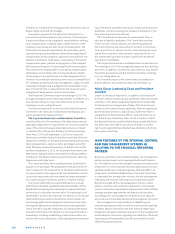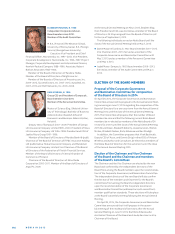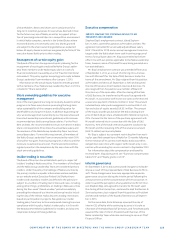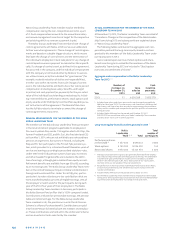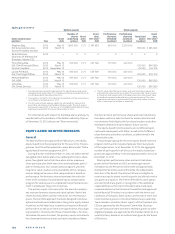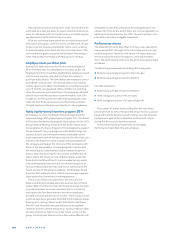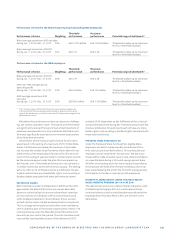Nokia 2013 Annual Report Download - page 123
Download and view the complete annual report
Please find page 123 of the 2013 Nokia annual report below. You can navigate through the pages in the report by either clicking on the pages listed below, or by using the keyword search tool below to find specific information within the annual report.121
COMPENSATION OF THE BOARD OF DIRECTORS AND THE NOKIA GROUP LEADERSHIP TEAM
evant companies with the same or similar revenue, size, global
reach and complexity that we believe we compete against for
executive talent. For , the peer group included companies
in high technology, telecommunications and Internet ser-
vices industries, as well as companies from other industries
that are headquartered in Europe and the United States. The
peer group is determined by the Personnel Committee and
reviewed for appropriateness from time to time as deemed
necessary to keep abreast of changes in the business environ-
ment or industry.
The Personnel Committee retains and uses an external com-
pensation consultant from Mercer Human Resources to obtain
benchmark data and information on current market trends.
The consultant works directly for the Personnel Committee
and meets annually with the Personnel Committee, with-
out management present, to provide an assessment of the
competitiveness and appropriateness of Nokia’s executive
compensation levels and programs. Management provides
the consultant with information regarding Nokia’s compensa-
tion levels and programs in preparation for meeting with the
Committee. The Committee has reviewed and established that
the consultant of Mercer Human Resources that works for the
Personnel Committee is independent of Nokia and does not
have any other business relationships with Nokia.
The Personnel Committee reviews the Nokia Group
Leadership Team’s compensation on an annual basis, and from
time to time during the year when special needs arise. Without
management present, the Personnel Committee evaluates
the performance of the President and CEO against previously
established goals and objectives, recommends corporate
goals and objectives for the coming year and proposes to the
Board the compensation level of the President and CEO. All
compensation for the President and CEO, including long-term
equity incentives, is approved by the Board and is confi rmed
by the independent members of the Board. Management’s
role is to provide any information requested by the Personnel
Committee to assist in their deliberations.
Upon the recommendation of the President and CEO, the
Personnel Committee also approves all compensation, in-
cluding long-term equity incentives and goals and objectives
relevant to compensation for all members of the Nokia Group
Leadership Team (other than the President and CEO) and
other executive level direct reports to the President and CEO.
Additionally, the Personnel Committee approves annual short-
term incentive payments and reviews the results of perfor-
mance evaluation of Nokia Group Leadership Team members
(excluding the President and CEO) and other executive level
direct reports to the President and CEO.
The Personnel Committee considers the following factors,
among others, when determining the compensation of the
Nokia Group Leadership Team or recommending the compen-
sation of the President and CEO to the Board:
■ the compensation levels for similar positions (in terms of
scope of position, revenues, number of employees, global
responsibility and reporting relationships) in relevant com-
parison companies;
■ the performance demonstrated by the executive offi cer
during the last year, which is evaluated at the end of the year
against individual goals that are aligned to Nokia-level fi nan-
cial and strategic goals and against the executive offi cer’s
overall leadership capabilities;
■ the size and impact of the particular offi cer’s role on Nokia’s
overall performance and strategic direction;
■ the internal comparison to the compensation levels of the
other executive offi cers of Nokia;
■ past experience and tenure in role; and
■ the potential and expected future contributions of the
executive.
The above factors are assessed by the Personnel
Committee in totality.
In , Nokia’s management performed an internal risk
assessment of Nokia’s compensation policies and practices for
all its employees specifi cally to understand any potential risk
factors that would be associated with the changes made to
Nokia’s compensation programs in in alignment with our
strategy. Management assessed such factors as Nokia’s pro-
portion of fi xed compensation in relation to variable compen-
sation, the caps on incentive compensation that can be earned
under our plans, performance metrics tied to the incentive
programs and the time horizon over which variable compen-
sation may be earned, as well as Nokia’s share ownership,
severance and recoupment policies and our overall governance
structure and practices. Based on the assessment, manage-
ment concluded that there were no material risks arising from
Nokia’s compensation programs, policies and practices or the
changes implemented that are likely to have a material adverse
eff ect on Nokia. The fi ndings of the analysis were reported to
the Personnel Committee. A similar assessment was not con-
ducted in , as the assessment considered changes
in our programs that were being implemented in . In
a full risk assessment will be conducted based on Nokia’s new
strategy.
Components of executive compensation
Our compensation program for Nokia Group Leadership Team
members includes annual cash compensation in the form of a
base salary and short-term variable cash incentives, as well as
long-term equity-based incentives in the form of performance
shares, stock options and restricted shares.
ANNUAL CASH COMPENSATION
Base salaries are targeted at globally competitive market lev-
els. The Personnel Committee evaluates and weighs as a whole
the appropriate base salary levels based on both our European
and US peer companies.
Short-term cash incentives are an important element of
our variable compensation programs and are tied directly to
Nokia-level fi nancial and strategic goals that are shared by the
Nokia Group Leadership Team. The annual short-term variable
cash incentive is expressed as a percentage of Nokia Group
Leadership Team member’s annual base salary. These award
and measurement criteria are presented in the table below.
Annual short-term variable incentives are normally deter-
mined for the Nokia Group Leadership Team based on their
performance as a team. We began with a team scorecard
made up of Nokia fi nancial and strategic targets. As a result



